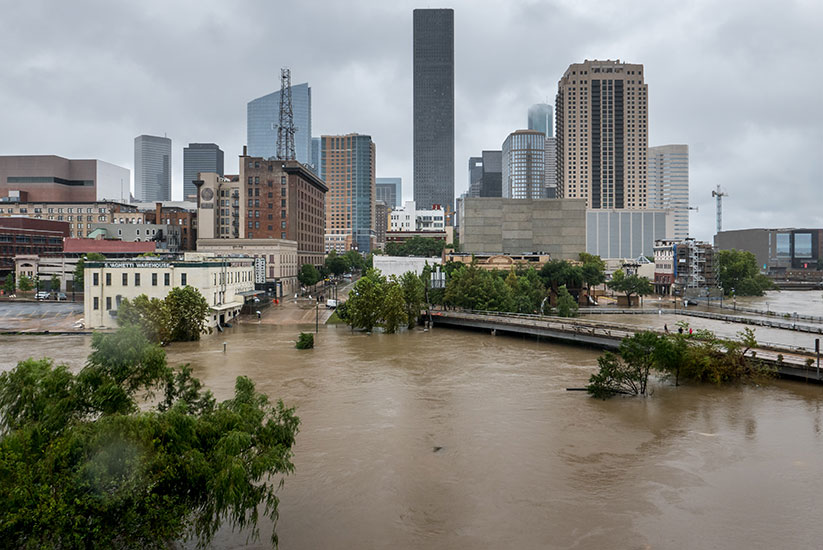As Harvey Dissipates, Texas Architectural Community Takes Stock of Storm's Impact on Cultural Projects

Downtown Houston, as seen from the University of Houston Downtown campus, across Buffalo Bayou, on August 27, 2017
Photo © Peter Molick

A submerged off-ramp from Interstate 45 South, leading into Sowntown Houston, on August 27, 2017
Photo © Peter Molick

The Riesner Building (the future home of AIA Houston and Architecture Center Houston) on August 27, 2017
Photo © Peter Molick

Rendering of the Menial Drawing Institute by Johnston Marklee
Image courtesy Johnston Marklee/The Menil Collection

Model of the Nancy and Rich Kinder Building at the MFAH by Steven Holl Architects
Image courtesy Steven Holl Architects

Rendering of the Sarah Campbell Blaffer Center for Conservation at the MFAH by Lake|Flato Architects
Image courtesy Lake|Flato Architects

Brochstein Pavilion at Rice University by Thomas Phifer and Partners, taken shortly after completion
Photo © Scott Frances

Twilight Epiphany at Rice University by James Turrell with Thomas Phifer and Partners, taken shortly after completion
Photo © Casey Dunn for Texas Monthly

The Rockport Center for the Arts after Hurricane Harvey
Photo courtesy of the Rockport Center for the Arts

The Rockport Center for the Arts after Hurricane Harvey
Photo courtesy of the Rockport Center for the Arts










Six days after Hurricane Harvey made landfall in south Texas, lashing coastal cities with driving wind and rain, the storm has moved on to other states. Now residents and officials begin to assess the damage from the storm that dumped 9 trillion gallons of water on the state and has left at least 38 people dead. Thousands more are unable to return to their homes because, in some parts of the city, the floodwaters have not yet receded. AccuWeather forecasts an economic impact of $190 billion—more than that of Hurricanes Katrina and Sandy combined.
With a population of about 6 million and an size comparable to that of Massachusetts, the Houston metropolitan area weathered days of intense downpours that summed to more than 50 inches of rain in a few places, marking the greatest amount ever recorded in the lower 48 states from a single storm. Faced with months of cleanup and likely years of reconstruction, the city has a long road ahead. Along with the human toll, residential destruction, and infrastructure damage, there are other losses. This week, Houston's art and architectural communities are beginning to take stock of the damage to historic and contemporary structures, as well as cultural projects still under construction.
Flowing west to east through Houston, Buffalo Bayou topped its banks as the waters rose, inundating residential neighborhoods, freeway interchanges, and entire city blocks downtown, including performing arts spaces in the Theatre District. The basements of Jones Hall, designed in 1966 by Caudill Rowlett Scott (CRS) and home to the Houston Symphony, along with the Alley Theatre, a Brutalist ensemble designed in 1968 by Ulrich Franzen, were flooded.
AIA Houston and Architecture Center Houston had been planning a move from the organizations’ offices in Bayou Place—the old Albert Thomas Convention Center, redeveloped as a mixed-use complex in Buffalo Bayou Park—to a historic building about a mile away. But now, both locations are damaged, according to Executive Director Rusty Bienvenue. Basement flooding in the current office ruined books and old exhibition materials. The center’s new space—a renovation by Murphy Mears Architects of the 1906 Riesner Building—was planned to include a steel floodgate and protective panels, but installation was not complete when Harvey struck. The structure, located just one block from the bayou, took on about 4 feet of water. The new offices were only weeks away from completion.
Nearby, Allen's Landing marks where Houston was founded in 1836. There, the Buffalo Bayou Conservancy is in the process of revitalizing the Sunset Coffee Building, a 1910 brick structure on the bayou's shore, with a renovation by Lake|Flato Architects. The firm’s marketing director Robert Hoang said the first floor of the structure was designed to accommodate flooding, but because waters have just started to recede, the Conservancy had not yet assessed the damage.
Other art spaces fared better. The Blaffer Art Museum, which WORKac renovated and expanded in 2012, was not damaged and will re-open after Labor Day. The Menil Collection, with two buildings designed by Renzo Piano Building Workshop and the Drawing Institute by Johnston Marklee under construction, likewise was not flooded, according to Tommy Napier, assistant director of communications.
The Menil campus also includes the Rothko Chapel, a Dan Flavin installation at Richmond Hall, and the Byzantine Fresco Chapel. The collection will reopen to the public Friday morning.
The Museum of Fine Arts, Houston’s “Hurricane Preparedness Task Force” and on-site emergency undertook advance planning measures, according to Mary Haus, head of marketing and communications. As a result, its main Sarofim Campus, located in the Museum District, is safe, though flooding occurred at its Bayou Bend Collection and Gardens in the upscale River Oaks neighborhood. Active construction to expand the main campus will add two new buildings by Steven Holl Architects, a conservation center by Lake|Flato, and underground parking garages and tunnels. The work sites took on water but are otherwise intact.
New buildings at Rice University were not affected, though some older structures experienced minor leaks. Recent additions to the campus include Thomas Phifer Architects' Brochstein Pavilion, Michael Maltzan Architects' Moody Center, and Kieran Timberlake's Brockman Hall for Physics. Rice's public art collection features Twilight Epiphany, a James Turrell skyspace in a pavilion designed by Phifer, among other works; all are “in great shape,” according to Evan Garza, director of Rice Public Art.
While this is good news, Harvey also wreaked havoc on cultural facilities up and down the Texas coast, with widespread destruction in Port Aransas and Rockport. The existing Rockport Center for the Arts, where Lake|Flato is building an expansion, was seriously damaged. A public message from its executive director said it was “unclear if all sculptures in the Sculpture Garden survived the 130 miles-per-hour winds.” Remarkably, however, the Art Museum of South Texas (AMST) in Corpus Christi, which occupies a waterfront location on the Gulf of Mexico, emerged unscathed. Housed in a 1972 Philip Johnson design with an addition in 2006 from Legorreta + Legorreta, the museum will re-open this morning. “AMST,” its website announces, “is South Texas Strong.”
As the days, weeks, and months go by, the full extent of Harvey's architectural impact — as well as its impact on the larger community and economy — will become clearer. Though flooding is not a new problem for Houston, the city’s future resiliency demands new solutions.
Want to help? Check out these resources from the AIA's Disaster Assistance Program and the Texas Society of Architects, or contribute to one of the many disaster relief organizations around the state.












